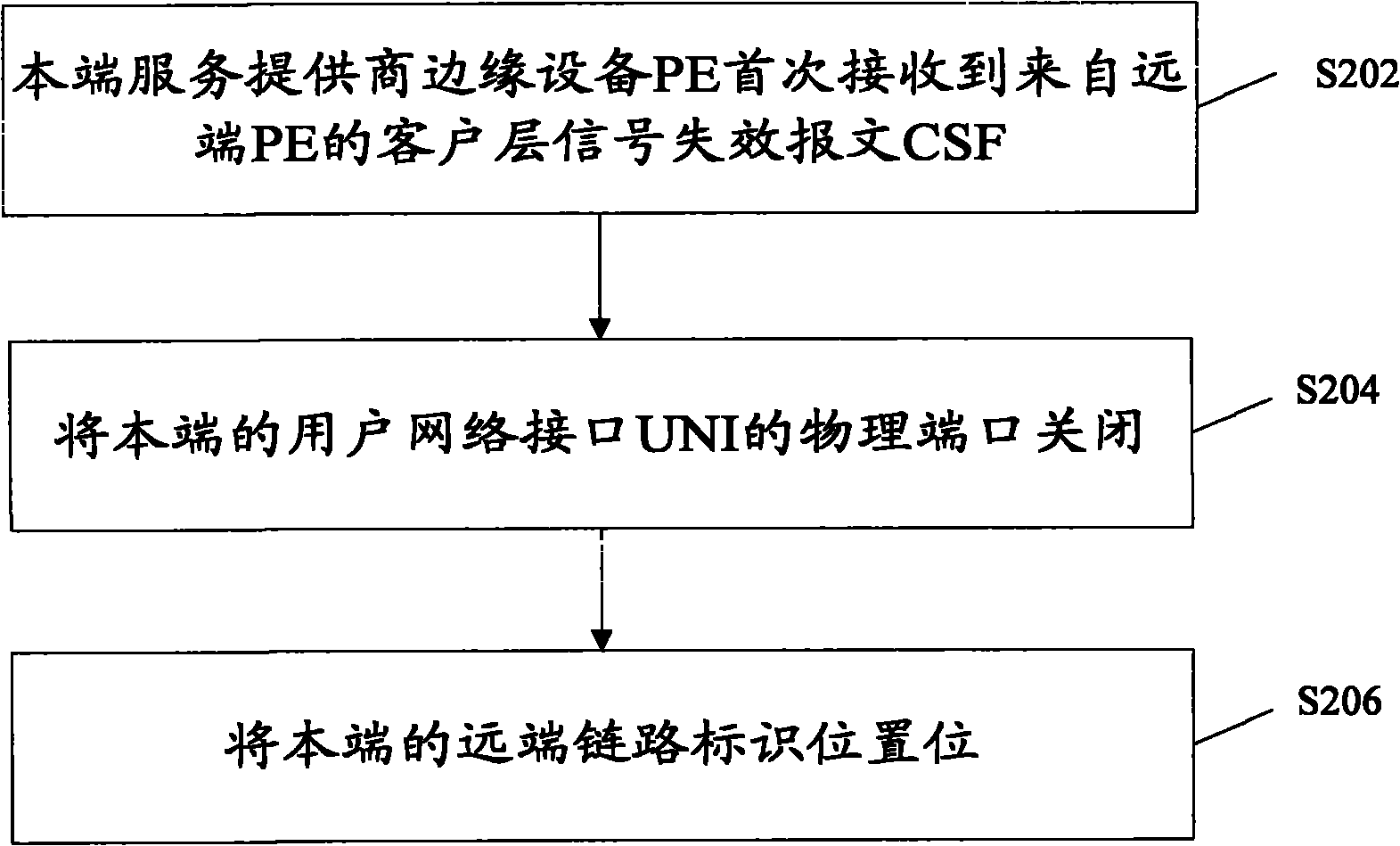Link state delivery method and device of packet transport network
A packet transport network and link state technology, applied in transmission systems, digital transmission systems, data exchange networks, etc., can solve problems such as deadlocks, inconsistent states, and ineffective triggering of signal failure packets, and achieve deadlock solutions. , the effect of improving reliability
- Summary
- Abstract
- Description
- Claims
- Application Information
AI Technical Summary
Problems solved by technology
Method used
Image
Examples
Embodiment 1
[0070] Such as Figure 8 As shown, this embodiment describes the CE1-PE1 service port signal state detection and management.
[0071] When a CE1-PE1 link fault occurs, perform the following steps:
[0072] In step S802, it is judged whether it is detected that the CE1-PE1 link is down for the first time, and if yes, step S804 is executed.
[0073] In step S804, it is further judged whether the UNI physical port is set with the remote link identification bit. If it is set, it means that the CE1-PE1 link down is the transmission of the remote link status, and returns directly without processing to prevent deadlock.
[0074] Step S806, if the remote identification bit is empty, further judge whether the public network client layer is in the SF state, and if the client layer fails, return without processing.
[0075] In step S808, when the down of the UNI port is neither caused by the remote link nor the public network, but the link of CE1-PE1 itself is abnormal, a CSF message i...
Embodiment 2
[0080] Such as Figure 9 As shown, this embodiment describes the client service state management of the remote PE2.
[0081] When receiving the CE1-PE1 link defect notification sent by PE1, perform the following steps:
[0082] Step S902, judging whether the CSF message sent by PE1 is received for the first time.
[0083] In step S904, if the CSF message is received for the first time, it means that the remote CE1-PE1 link is down, and the UNI physical port of the local end is set to the remote identification bit.
[0084] Step S906, judge whether the UNI physical port of CE2-PE2 is down, if the port of CE2-PE2 is down, do not process, and return.
[0085] Step S908, if the UNI physical port of CE2-PE2 is up, then close the UNI physical port, and the user equipment CE2 can perceive that the remote user equipment CE1 is unreachable.
[0086] When receiving the CE1-PE1 link defect disappearance notification sent by PE1, perform the following steps:
[0087] Step S910, judging ...
Embodiment 3
[0093] Such as Figure 10 As shown, this embodiment describes signal detection at the client layer of PE1-PE2 on the public network.
[0094] The detection of part of the client layer signal on the public network can be deployed on the service layer, including the tunnel and link layer. At this time, it is necessary to record the binding relationship between the service layer tunnel or the link layer and the client layer to propagate the failure signal; it can also be deployed On the client layer PW. You can choose according to different needs.
[0095] Step S1002, whether the network manager wants the OAM message to work at the service layer, needs to pay attention to the status of the service layer and the client layer at the same time.
[0096] Step S1004, if yes, configure the OAM detection message to work in the service layer, configure the predetermined expiration time, etc., and enable the propagation function, when the service layer detects the failure, it can propag...
PUM
 Login to View More
Login to View More Abstract
Description
Claims
Application Information
 Login to View More
Login to View More - R&D
- Intellectual Property
- Life Sciences
- Materials
- Tech Scout
- Unparalleled Data Quality
- Higher Quality Content
- 60% Fewer Hallucinations
Browse by: Latest US Patents, China's latest patents, Technical Efficacy Thesaurus, Application Domain, Technology Topic, Popular Technical Reports.
© 2025 PatSnap. All rights reserved.Legal|Privacy policy|Modern Slavery Act Transparency Statement|Sitemap|About US| Contact US: help@patsnap.com



